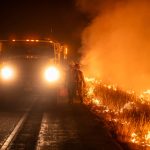Drivers in Colorado could soon pay more for car insurance as tariffs hit auto parts
Car insurance premiums in Colorado could see higher markups than anticipated by the end of 2025 thanks to the Trump administration’s tariffs impacting car materials

Jaymin Kanzer/Post Independent
Car insurance premiums are expected to go up for Coloradans by the end of 2025 — but the increase could be higher than initially expected, thanks to the rising cost of auto parts driven by the Trump’s administration’s tariffs on car manufacturing materials.
For most car insurance companies, 2025 was supposed to be a relatively stable year for rates following years of premium increases. Nationally, rates were steady during the first half of the year and even decreased in 27 states, according to an August report by digital insurance platform Insurify. Cost impacts from President Donald Trump’s widespread tariffs and inflation, however, could cause premiums to go in the opposite direction.
“We were on a track (to see) year-over-year increasing premiums. But more recently, we have seen a softening in the market where we’re seeing a stabilization of rates and even a downward trend,” said Carole Walker, executive director of the Rocky Mountain Insurance Association. “But now, you add a large element of unknown with the tariffs, where there’s no such thing as a 100% American-made car.”
Insurify projects that the cost of full-coverage car insurance could climb 7% nationally by the end of 2025 if tariffs persist — or a 6% increase in Colorado. While insurance costs were already expected to climb in the state by the end of the year, the increase would have been closer to 3% or 4% without tariffs.
The U.S. has imposed several rounds of tariffs resulting in raising the prices for auto parts — such as the Trump administration’s 25% tariffs on foreign automobiles and auto parts, with certain exemptions — which in turn brings up the cost of repair claims for insurers. Paired with the rise in inflation since April, claims are becoming more costly to cover as insurers pay more to replace foreign-sourced car parts.
Since the implementation of the administration’s auto part tariffs, the country has struck trade deals with countries like Japan and South Korea to decrease tariffs on imports of automobiles and auto parts from 25% to 15%, which could partially ease the projected premium increases.
“That high cost repair is what really is going to affect your insurance premiums, along with an increased number of clients,” Walker said.
In general, the cost for some car repairs is even higher now than it was 10 years ago thanks to the innovations of electric and “smart” cars.
“We’re driving around computer chips, basically,” Walker said. “So the high cost of high tech, high cost to repair everything from the parts to the labor is causing insurance premiums to rise.”
The forecasted rise comes after a hectic past few years for drivers and insurance companies. A post-pandemic surge in driving meant more accidents and more expensive auto parts thanks to inflation, resulting in rising rates to keep up with increased risks. From June 2022 to June 2024, the average annual cost of insurance in the U.S. rose by more than 40% — upward of $700, according to the report.
Now, the higher costs of auto-repair parts brought on by tariffs are threatening to drive up the cost of insurance claims, which could be passed onto insured drivers.
“You look at foreign imports of cars and then foreign parts from aluminum to steel, where we’re going to see those tariffs impact in ways that really we’re not sure of,” Walker said. “We’ve seen a lot of volatility in how the tariffs are applied. … But insurance companies are in the position of, ‘Okay, how do we account for these increased costs put in by tariffs?'”
Colorado’s annual cost of car insurance was projected to be at $2,880 by the end of 2025. When factoring in tariffs on auto parts, that projection has shifted to $2,964 — a 5% year-over- year increase — according to Insurify.
Walker said Colorado is ranked close to the middle for highest car insurance costs. In 2018, data from the Insurance Research Council identified that Coloradans on average spend close to 1.55% of their median household income on car insurance — the 22nd highest in the country.
As of June 2025, the average annual cost of car insurance in Colorado is $2,801 — roughly $500 more than the national average cost of $2,310.
Colorado has already seen the impacts of these tariffs on the housing industry, where experts say that tariffs on essential construction materials such as steel, aluminum and lumber could soon drive up home prices.
Estimating if and when tariffs could start to raise car insurance rates is complicated, Walker said. Some experts say it could take months for tariff costs to flow to individual policies.
“We’re not sure what those increased costs are going to be long term,” she said.
Economists with Insurify say insurance is heavily regulated, and that insurers are traditionally required to prove to state regulators that tariffs have driven up their costs before they’re allowed to raise rates. Some insurers may have already adjusted their premiums to account for the higher costs and could plan to lower them as things stabilize in the future.
Currently, the largest driver for rates in Colorado is hail, which isn’t as prominent on the Western Slope as it is in other parts of the state, according to Walker.
What can drivers do to prepare for higher premiums?
Despite the uncertainty circulating in the car insurance industry around tariffs, drivers can still take steps to keep their car insurance premiums affordable.
Walker said the best thing Colorado drivers can do to save money as premiums continue to rise is to be a “savvy consumer.” This means understanding how the vehicle they choose to purchase could impact their insurance premiums, knowing what exactly is covered by their chosen insurance, and taking the time to compare different insurance options to make the best possible purchase.
“It’s important to shop around,” she said. “The trends are actually showing us that … consumers are increasingly shopping around for insurance. That’s a good idea.”
In addition, some companies offer opt-in telematics, or devices installed in vehicles to track driving habits, to earn discounts.
“The biggest thing you control is how you drive and how good of a driver you are,” Walker said. “Those are all things that your insurance company is weighing when it comes to charging you a premium.”
In addition to the concerns held by drivers over higher premiums, insurers are growing increasingly worried that this upward pricing could push more people into the “uninsured” category of drivers. According to data released by the Insurance Research Institute in 2024, Colorado is among the top 10 states with the highest number of uninsured drivers.
“Colorado does have a higher uninsured motorist population than the rest of the country already, and unfortunately, we see affordability and rising rates as the biggest factor increasing our uninsured motorists population,” Walker said. “We hope people won’t choose to go without insurance, but at the same time, we know when people are struggling to pay their grocery bill, (they have to decide) whether they’re going to drive legally or illegally without insurance.”

Support Local Journalism

Support Local Journalism
Readers around Glenwood Springs and Garfield County make the Post Independent’s work possible. Your financial contribution supports our efforts to deliver quality, locally relevant journalism.
Now more than ever, your support is critical to help us keep our community informed about the evolving coronavirus pandemic and the impact it is having locally. Every contribution, however large or small, will make a difference.
Each donation will be used exclusively for the development and creation of increased news coverage.










